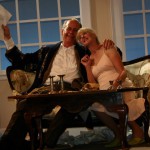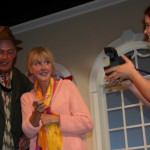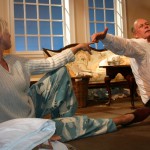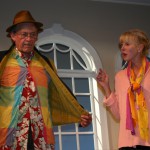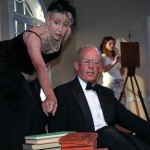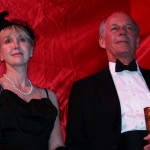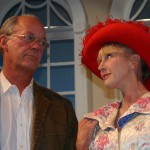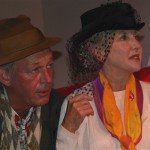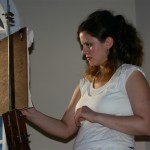GENERAL INFO
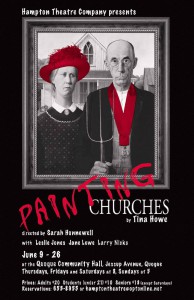
by Tina Howe
directed by Sarah Hunnewell
June 9 – 26, 2005
CAST:
Fanny Church – JANE LOWE
Gardner Church – LARRY NICKS
Margaret Church – LESLIE JONES
WHO'S WHO
LESLIE JONES (Margaret Church) is thrilled to be working with the Hampton Theatre Company this summer on such a wonderful show. She studied theater at Vanderbilt University and at the American Academy of Dramatic Arts in New York. Previous roles include Ariel in THE TEMPEST, Corinna in HO– USE OF BLUE LEAVES, Popova in THE BEAR and Irene in CRAZY FOR YOU.
JANE LOWE (Fanny Church) began her career as a dancer, performing in major theaters and opera houses throughout the world, including the Kennedy and Lincoln Centers, with the Louis Falco and James Cunningham dance companies. She was in the Broadway production of OH, CALCUTTA! and appeared as a Kit-Kat girl in the premiere of CABARET in Berlin, Germany. Jane has also appeared in many Off and Off-Off Broadway productions. Some favorite roles are Rosalind in AS YOU LIKE IT, Amanda in PRIVATE LIVES, Gorgeous in THE SISTERS ROSENSWEIG, Blanche in A STREETCAR NAMED DESIRE, Katherine in A PERFECT GANESH and Claire in RUMORS. Jane was also a principal in more than 25 national commercials and several independent films. Most recently she performed in FROM THE HORSE’S MOUTH at the Doris Duke Theater on 42nd Street and at Jacob’s Pillow. Jane is a graduate of The Julliard School.
LARRY NICKS (Gardner Church) is happy to be working with the Hampton Theatre Company once again. He played Robert in last fall’s production of PROOF and Dr. John Buchanan, Sr. in SUMMER AND SMOKE at Guild Hall. On Broadway he worked with Sean Penn and J.C. Quinn in Art Wolf’s production of HEARTLAND. Off Broadway he enjoyed working with Richard Karn and director Andy Cadiff in LOSING IT. Off Broadway he also appeared in the two character comedy CARIBBEAN COUPLES. Larry has appeared as a principal in many commercials, but none lately.
TINA HOWE (Playwright) has been writing for the stage for more than thirty years. Her best known works include PAINTING CHURCHES (nominated for the Pulitzer Prize in 1984), COASTAL DISTURBANCES (nominated for a Tony Award in 1987 and produced by the HTC in 1991), THE ART OF DINING, APPROACHING ZANZIBAR and PRIDE’S CROSSING (nominated for the 1997 Pulitzer Prize and winner of the 1998 New York Drama Critics Circle Award for Best Play). Howe has also won an Obie Award for Distinguished Playwriting, an Outer Critics Circle Award, an American Academy of Arts and Letters Award in Literature, a Rockefeller grant, two NEA fellowships and a Guggenheim fellowship. Other works include ONE SHOE OFF, THE NEST, BIRTH AND AFTER BIRTH, M– USEUM and, most recently, WOMEN IN FLAMES.
SARAH HUNNEWELL (Director, Producer) is the Executive Director of the Hampton Theatre Company and has, at various times, produced, directed and acted for the company for the last fifteen years. Favorite directorial forays include last fall’s production of PROOF, SUMMER AND SMOKE, THE RAINMAKER, A VIEW FROM THE BRIDGE, ORPHANS, THE LAST YANKEE and A STREETCAR NAMED DESIRE. Many thanks to her wonderful cast and crew and, as always, to Jimmy for his help and support.
PETER MARBURY (Set Designer) is the resident set designer for the Hampton Theatre Company. He has managed, on a small budget, to recreate myriad environments including Victorian parlors and Cape Cod beaches. When not creating sets, Peter can be found in his studio, where he busies himself making sculpture. For relaxation, he grows vegetables in his garden.
SEBASTIAN PACZYNSKI (Lighting Designer) designed SUMMER AND SMOKE, PROOF and NIGHT WATCH for the Hampton Theatre Company as well as the new theater’s lighting system. He has designed lighting for theater, dance and special events in a number of Broadway, Off Broadway, Off Off Broadway and regional venues. He has also worked in film and television as the director of photography. Local design credits include RED HERRING, THE CHERRY ORCHARD, DRACULA, JULIUS CAESAR, MACBETH and HAMLET at the John Drew Theater and THE COMEDY OF ERRORS, THE TAMING OF THE SHREW, A WINTER’S TALE and TWELFTH NIGHT for the Hamptons Shakespeare Festival. Upcoming productions include MOBY DICK at the John Drew Theater.
CHAS ROEDER (Costume Designer) has designed costumes for over thirty HTC productions as well as community, dinner and children’s theater, reviews, summer stock, Off Broadway and national tours. He has been costume designer for CTC Theater Live, Quogue Junior Theater Troupe and Spindletop Productions. Since its conception, Chas has been an active committee member of the WHBPAC where he has designed both sets and costumes.
SANDRA LEE CLARK (Stage Manager) is primarily an actress whose history in theatre includes roles in SUNSET BOULEVARD, THE MIRACLE WORKER, THE PHILADELPHIA STORY, DEATHTRAP, THE MADWOMAN OF CHAILLOT, WAITING FOR LEFTY and, most recently, LOVERS AND OTHER STRANGERS at the Clare Rose Playhouse. She has studied theater at S.U.N.Y. Stony Brook, Dowling College and H.B. Studios. Although Sandra usually performs in front of the curtain, she has previously stage managed throughout Long Island and welcomes this opportunity to work with such a fine company.
KRISTIN SINKEL (Assistant Stage Manager) is thrilled to be working with the Hampton Theatre Company on yet another production. She has appeared both on stage and backstage with HTC and many other local theater groups. Most recently, Kristin was John Zaleski’s assistant on HTC’s production of NIGHT WATCH. In “real life,” Kristin works at the Veterinary Clinic of East Hampton and is “Mommy” to two dogs and four cats. She would like everyone to send good wishes to Joe Marchese at the John Drew as he battles a brain tumor. We love you Joe!
JENNIFER COHEN (Assistant Stage Manager) has previously stage managed COMPANY, FOLLIES, NOT ABOUT NIGHTINGALES and A CHORUS LINE with the Southampton Players and would like to thank her you-know-who for always being there and loving her.
JACQUIE BACHMAN (Lighting & Sound Technician) is a student at Stony Brook University and has been working at the Westhampton Beach Performing Arts Center for several seasons. Jacquie is pleased to be working with the Hampton Theatre Company again for another amazing production.
PRODUCTION STAFF
Director – SARAH HUNNEWELL
Producers – SARAH HUNNEWELL & DIANA MARBURY
Set Designer – PETER MARBURY
Lighting Designer – SEBASTIAN PACZYNSKI
Costumer Designer – CHAS ROEDER
Stage Manager – SANDRA LEE CLARK
Assistant Stage Managers – JENNIFER COHEN, KRISTIN SINKEL
Set Construction – RUSSELL BABIS, JAMES EWING, TED KISS, PETER MARBURY, SEAN MARBURY
Set Decor – DIANA MARBURY
Sound & Lighting Tech – JACQUIE BACHMAN
Production Graphics –
JOE PALLISTER
Advertising Sales – ELIZABETH GOODALE
House Manager – SY ROBIN
Program, Publicity, Props & Box Office – SARAH HUNNEWELL
REVIEWS
SUBSTANTIAL, THOUGHTFUL PRODUCTION
by Lee Davis
Oh, the angst of WASPdom! To be rich and troubled … and rich. But wait a minute. Those on the top couple of rungs of the social ladder, like Shylock, feel pain, too, and are human, too, and therefore deserve our attention and care as much as anyone else.
It may be that their largest problem is that it takes either closeness or talent to make most of us care. And that A.J. Gurney and Tina Howe have, in gracious abundance. Both have made it their business to chronicle the lives and lost fulfillments of a panoply of people of the privileged class. And, by God, they succeed in making us care.
So, it’s good to report that “Painting Churches,” Tina Howe’s 1983 Off-Broadway look in on a Boston WASP family that’s in the last throes of disassembly, is being given an absorbing production in Quogue by the Hampton Theatre Company, with fluid direction by Sarah Hunnewell and a cast of uniformly interesting and rewarding actors.
Ms. Hunnewell treats the story of the family of Gardner Church, a Pulitzer Prize-winning poet who’s descending into the steadily darkening tunnel of Alzheimer’s, as a contemporary fable. Peter Marbury’s sumptuous set, Charles Roeder’s faultless costumes, and particularly Sebastian Paczynski’s primary color lighting design have an unreal, dreamlike quality about them, as do the lives of the three characters—Gardner, his unforgiving and vociferously practical wife, Fanny, and their daughter, Margaret, an artist on the brink of fame who desperately needs the acceptance of her parents.
Most of their moments are made of memories and dreams, which constantly overlap, and the rhythms, the waves of movement of the play and the tensions that fire within these waves are composed of the collision of these memories and dreams with a more unforgiving reality.
The Churches are closing their Boston mansion and moving into their summer cottage full time so that Fanny can take care of Gardner as he steadily loses touch with the larger than life persona that has made him world famous. Margaret, on the verge of a major gallery show of her works, comes back from New York to paint her parents’ portraits, one last capturing of what once was and one last try at gaining her mother’s approval.
Her father loves her without question and without borders. Her mother, self-absorbed in her Boston Brahmin persona and milieu, has spent Margaret’s childhood trying to shoehorn her into a preconceived image, and has neither understood nor countenanced her artistic talents. And so, the play focuses upon the final collision of these forces.
Jane Lowe plays Fanny at a fever pitch with a purpose, which results in a good 15 early minutes of stridency. Admittedly, this is partly the fault of Ms. Howe’s expositional writing, and, as Ms. Lowe settles into her character, her delivery modifies in tandem with the writing as it too settles down and the adorable qualities of the characters emerge.
Here, the reasons for her maximum nervousness make themselves felt, as she reaches her level and balances a not altogether sympathetic character with a plaintive reality. (“Boy,” her daughter Margaret observes, as the patterns of a childhood repeat themselves in her adult visit, “you’re in a class by yourself when it comes to humiliation.”)
The strain of change and the toll taken by her efforts to balance a deep love of her fragmenting husband with the responsibilities of keeping him in touch with a steadily fading substantiality are all brought gradually to the surface of Ms. Lowe’s portrayal. Once she’s allowed by the playwright, she brings the complexities within her character into sometimes moving focus.
Larry Nicks is an extraordinarily sympathetic Gardner Church, veering adorably in and out of the present, acquiring a rock solid command of all he surveys when quoting poetry, and above all, lavishing love with unabated generosity on both mother and daughter, no matter the situation or the consequences. His is the saddest of three sad souls, and Mr. Nicks balances this in his character with gentle control.
The delight of the threesome is Leslie Jones’s delineation of Margaret, the artist daughter, back to paint a portrait and to once again face the humiliation of her mother and be wrapped in the arms of her fawning father. Ms. Jones infuses the story with a welcome solidity that contains volumes of pent-up emotion.
Her performance is never less than captivating, and is frequently transfixing. The tragedy of the play remains locked into fantasy until her arrival, and her efforts, over and over, to win the opprobrium of both, rather than one, of her parents is ultimately heartbreaking.
And so WASPs do suffer, and though “Painting Churches” never gets too dark, it does have the truth of the frailty of life and family relationships about it. And it’s being given a satisfyingly substantial, thoughtful production by the Hampton Theatre Company in its comfortably renewed home in Quogue.
A DYSFUNCTIONAL FAMILY PORTRAIT
by Steve Parks
Newsday – June 17, 2005
Mags paints for a living. But she’s never painted a church. Or a Church for that matter. You may have guessed as much if you’re familiar with Tina Howe’s fondness for word-play titles. Her “Coastal Disturbances” has as little to do with weather as “Painting Churches” does with houses of worship.
Except that there’s a devotion to creativity in the Church household. As the lights go up on this aptly eccentric Hampton Theatre Company incarnation, we notice that the triptych of arched windows of the living room forms a nave from which Fanny can bestow her matriarchal blessings and blandishments.
But right now her only vestments are an old bathrobe and an outlandish red hat she’s rescued from the thrift shop for 85 cents. She solicits the approval of her husband, Gardner, who’s preoccupied with his nonsensical writing like an addled chimp who might accidentally pound out “Hamlet.”
Gardner Church, we learn after daughter Margaret arrives for her annual visit, is a Pulitzer-winning poet. Fanny has devoted her life to taking care of the family laureate. And it shows. She hardly recalls any of her daughter’s childhood. But maybe it’s just the temporary amnesia that goes with packing up your life and moving it to the summer cottage on the Cape, where winter arrives early. The floor of their Boston home is strewn with packing boxes, wadded paper and tarnished silver pieces Fanny hopes will fetch a few months’ living expenses.
Ostensibly, Mags has come to help her parents pack. But her real agenda is to paint their portrait. That’s what she does when she’s not teaching at Pratt – paint portraits. “I’m so out I’m in,” she says of her first solo show in Manhattan.
But like most children, even long after growing up, Mags has never really regarded her parents as people. Her determination to capture them on canvas morphs into an accident of self-discovery.
Jane Lowe as Fanny and Larry Nicks as Gardner scuffle along in their packing like a mismatched pair of bedroom slippers – one his, one hers. Desperately clinging to her vanity, Lowe’s Fanny twinkles with the secrets of her semi-glamorous past, long forgotten by her husband, along with most everything that doesn’t involve rhyme or meter. Nicks dodders adorably as the writer who forgets the beginning of his sentence before he achieves its period. His absent donning of old clothes Fanny wants to give away recalls the mute antics of Bill Irwin.
Leslie Jones as Mags recoils in defensive regression at every disparaging remark by her mother, while glowing with each glimmer of the past she cajoles from Dad.
Director Sarah Hunnewell understands artsy people like the Churches – snobby to outsiders, cool to intimates. (They can’t help showing off taste and intellect even among themselves.) And while their remote orbits may resemble dysfunction, it feels like family, just as Peter Marbury’s living room set feels like home.
 Hampton Theatre Company
Hampton Theatre Company
